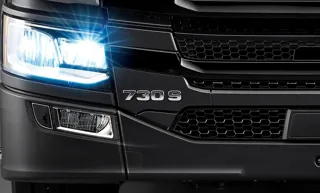The Scania DC07 engine has been added to the L-series line-up, with load-carrying capacity increasing by some 360 kilos.
The manufacturer says it is available in three different power outputs: 220, 250 and 280 hp.
Launched with a 9-litre engine, the L-series is already proving a success in the urban arena, says Scania. With the option of a 7-litre engine, it can now be optimised for a wider range of city-based operations.
“Initially, we primarily focused on certain applications with slightly heavier operations by offering the L-series with our five cylinder, 9-litre inline engines,” said Stefan Lindholm, senior product manager at Scania Trucks.
“However, what was assumed from the outset was later confirmed; there is a demand for solutions based on the lighter and more flexible 7-litre engine as well.”
Initially only offered in combination with P-series cabs, the Scania DC07 was launched in 2017.
It is a light-weight, robust and modern inline-six engine with a swept volume of 6.7 litres, offering up to 1,200 Nm of torque from 1,050 r/min in its most powerful 280 hp iteration.
It features Scania’s in-house designed exhaust gas aftertreatment system with SCR-only technology and can be fitted with engine-driven PTOs.
“It’s Scania’s smallest truck engine in a long time,” added Lindholm. “But it still carries all the well-known brand characteristics: class-leading fuel-efficiency, our low-rev philosophy and the ability to run on 100% HVO or FAME from new with up to 90% carbon-dioxide reduction.”
Scania believes that typical customers for the new combination will be found amongst hauliers and entrepreneurs that wish to maximise safety on daily operations in urban areas.
Many of these companies will be focused in the distribution, construction and refuse collection sectors, but the L-series is equally well suited to all urban applications, says Scania.
In this environment good visibility, superior driver environment, and a favourable total operating economy are decisive.
L-series cabs are available in three different roof heights: low, normal and high. If ordered with the kneeling function, it takes just one step to enter into the cab with a floor height around 80 centimetres.
Typical axle configurations for urban application rigids are 4x2, 6x2*4, and 8x4*4 (with Scania’s electrically steered tag axle).
“Trucks such as these often operate in distribution and municipal applications, but we see more and more tailor-made, construction-oriented trucks as well,” said Lindholm. “Many construction vehicles spend most time on congested city streets. Here, an L-series tipper with the DC07 280 hp and the right gearing could be ideal.”























Login to comment
Comments
No comments have been made yet.